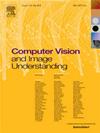Specular highlight removal using Quaternion transformer
IF 4.3
3区 计算机科学
Q2 COMPUTER SCIENCE, ARTIFICIAL INTELLIGENCE
引用次数: 0
Abstract
Specular highlight removal is a very important issue, because specular highlight reflections in images with illumination changes can give very negative effects on various computer vision and image processing tasks. Numerous state-of-the-art networks for the specular removal use convolutional neural networks (CNN), which cannot learn global context effectively. They capture spatial information while overlooking 3D structural correlation information of an RGB image. To address this problem, we introduce a specular highlight removal network based on Quaternion transformer (QformerSHR), which employs a transformer architecture based on Quaternion representation. In particular, a depth-wise separable Quaternion convolutional layer (DSQConv) is proposed to enhance computational performance of QformerSHR, while efficiently preserving the structural correlation of an RGB image by utilizing the Quaternion representation. In addition, a Quaternion transformer block (QTB) based on DSQConv learns global context. As a result, QformerSHR consisting of DSQConv and QTB performs the specular removal from natural and text image datasets effectively. Experimental results demonstrate that it is significantly more effective than state-of-the-art networks for the specular removal, in terms of both quantitative performance and subjective quality.
利用四元数变换器去除镜面反射高光
去除镜面高光是一个非常重要的问题,因为在光照变化的图像中,镜面高光反射会给各种计算机视觉和图像处理任务带来非常负面的影响。许多用于去除镜面反射的先进网络都使用卷积神经网络(CNN),但这种网络无法有效学习全局上下文。它们在捕捉空间信息的同时,忽略了 RGB 图像的三维结构相关信息。为了解决这个问题,我们引入了基于四元数变换器的镜面高光去除网络(QformerSHR),它采用了基于四元数表示的变换器架构。特别是,我们提出了深度可分离四元卷积层(DSQConv),以提高 QformerSHR 的计算性能,同时利用四元数表示有效地保留 RGB 图像的结构相关性。此外,基于 DSQConv 的四元数变换器块(QTB)可学习全局上下文。因此,由 DSQConv 和 QTB 组成的 QformerSHR 能有效地去除自然和文本图像数据集中的镜面反射。实验结果表明,无论从定量性能还是主观质量来看,它都比最先进的去除镜面反射的网络有效得多。
本文章由计算机程序翻译,如有差异,请以英文原文为准。
求助全文
约1分钟内获得全文
求助全文
来源期刊

Computer Vision and Image Understanding
工程技术-工程:电子与电气
CiteScore
7.80
自引率
4.40%
发文量
112
审稿时长
79 days
期刊介绍:
The central focus of this journal is the computer analysis of pictorial information. Computer Vision and Image Understanding publishes papers covering all aspects of image analysis from the low-level, iconic processes of early vision to the high-level, symbolic processes of recognition and interpretation. A wide range of topics in the image understanding area is covered, including papers offering insights that differ from predominant views.
Research Areas Include:
• Theory
• Early vision
• Data structures and representations
• Shape
• Range
• Motion
• Matching and recognition
• Architecture and languages
• Vision systems
 求助内容:
求助内容: 应助结果提醒方式:
应助结果提醒方式:


